The American Staffing Associations annual economic analysis or “playbook” of 2020 is very well done, complete with charts and graphs, figures and key takeaways. I found the new hires and job openings graph, the labor participation rate, the GDP, Staffing Index and employee turnover chart most interesting and provided key takeaways to share.
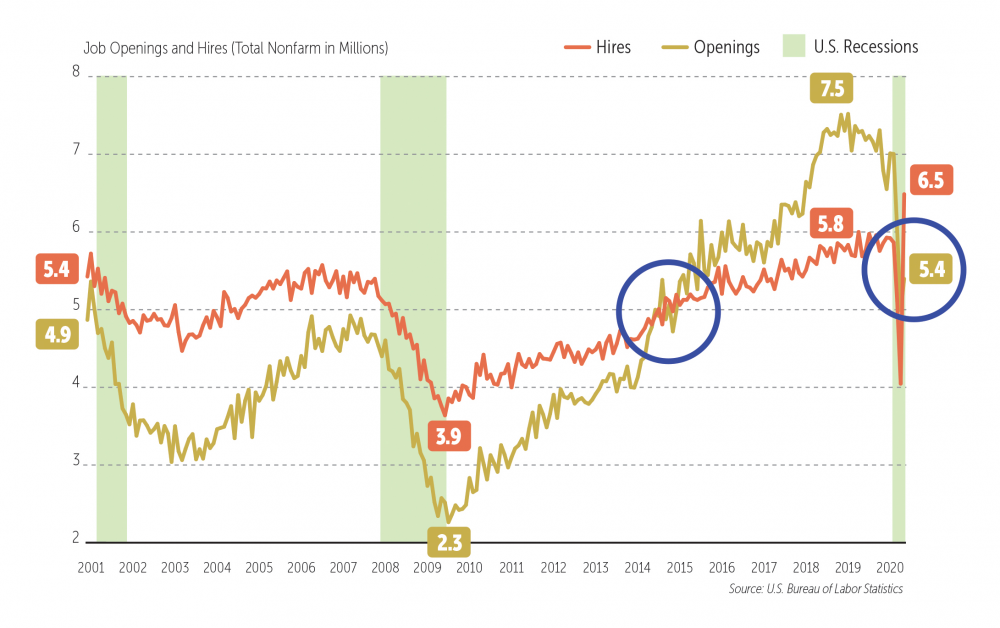
The economy and employment trends have been altered in many different ways this year. New hires (shown in orange) have always indicated how the economy and workforce is fairing, while job openings (shown in gold) have been a “lagging indicator” of the economy. Three recessions are depicted in green beginning in 2001, 2008 and 2020. In 2014 job openings exceeded new hires. In late 2018, there were 7.5 million job openings and 5.8 million hires. In May of this year the trend reverted to a history breaking 6.5 million hires with 5.4 million job openings, due to Covid-19. Our new workforce will need more training and reskilling as hires again exceed job openings.
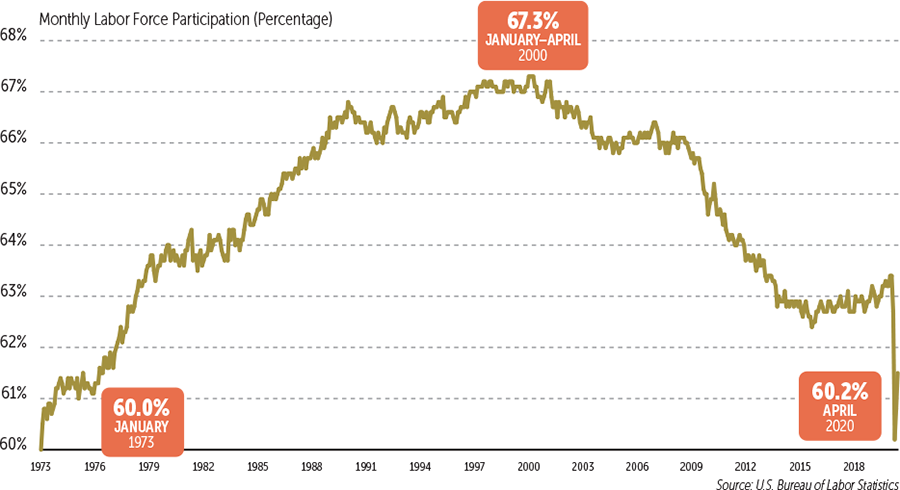
An opportunity for staffing industry firms to retool and determine how they can most successfully impact the 50 year low, labor force participation rate can be found here.
“With the abrupt halt to economic expansion and employment growth caused by the Great Shutdown, economists posit that it will be years before the labor market and participation rate recover to even the moderate levels seen over the past five years. Employers, including staffing companies, will need to be open to new possibilities and get creative in how they source and place qualified talent.” From its peak at 67% in April 2000, the labor force participation rate has been gradually declining over the last two decades, per the U.S. Bureau of Labor Statistics. With 60.2% this year, it’s almost at a 50-year low as a result of the pandemic and is where the employment crisis began.
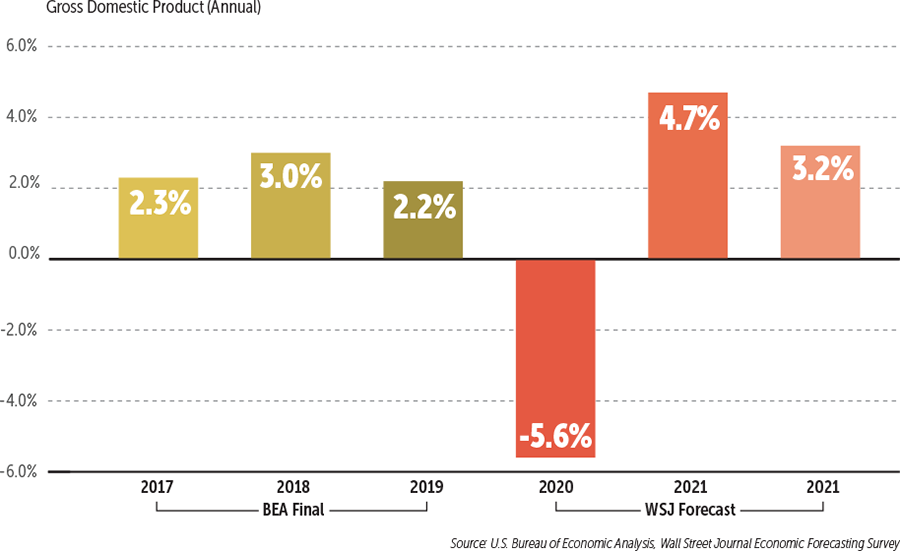
GDP is another economic measure many rely on, however, these forecasts and government estimates are often delayed and revised. The Wall Street Journal surveyed economists who are not optimistic about the end of 2020 with the pandemic crisis in play and report an almost 6% negative growth rate. They forecast a rally next year in 2021. And, although lower than 2021, growth is estimated to be higher in 2022 than that of the prior 3 years between 2017 and 2019.
To update the Staffing Index chart below as of the writing of this article, the Staffing Index was 88 on week 47 (11/22/20). A fairly decent and continued upward trend. The record low of the Staffing Index of 60 occurred earlier this year as a result of Covid-19.
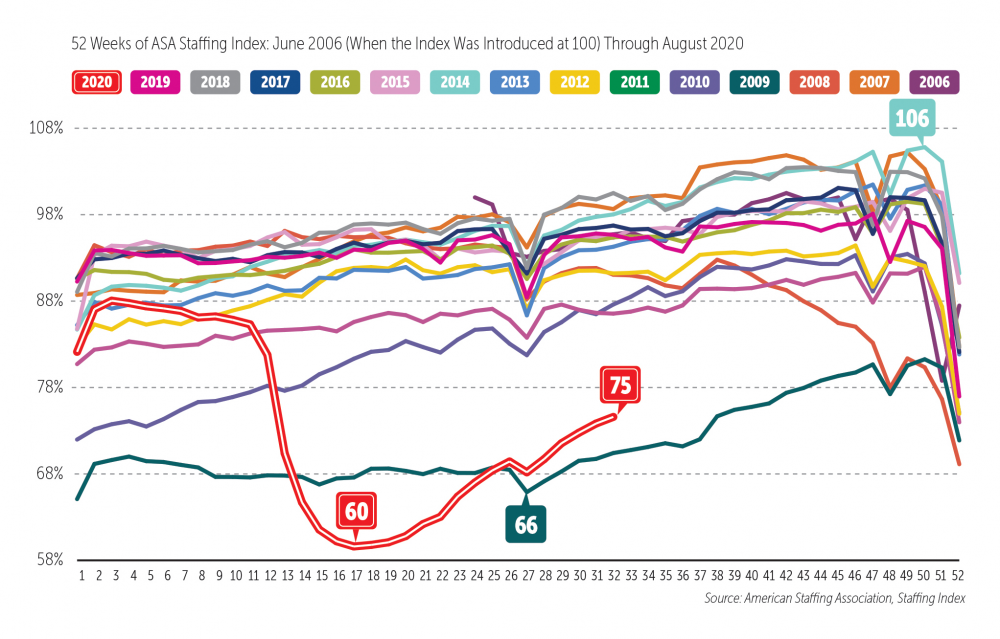
The Great Recession of 2009 resulted in the index number of 66. The American Staffing Association started providing the Staffing Index in June of 2006, introduced at 100.
“Historically, staffing employment has served as a coincident economic indicator. Because the ASA Staffing Index measures weekly changes in staffing employment, it bears watching as a near real-time indicator of current economic conditions, especially during volatile times for the labor market and economy.” ASA offers the ability to follow these trends on a weekly basis at americanstaffing.net/index.
The Staffing Index and its ability to potentially predict the economy has been analyzed over the years, in detail. The conclusion of extensively reviewing this index notes that a continued growth in temporary staffing signals the end of a recession and that employment would grow about 3 months later.
The employee turnover chart gave me some solace. In 2020, it seems the world has been in utter chaos of the likes we haven’t experienced before. Yet, I realized that prior years have had their own share of turmoil and misunderstanding. I noticed employee turnover and actually many of these statistics being shared, are neither continually up or down. I wouldn’t have guessed that employee turnover was worse in 2000 than it was in both 2018 and 2019. I think it’s important to realize that the economy, the workforce, job openings, and new hires are all cyclical. Actually, it isn’t continuing to get worse year over year. Ten to 11 weeks of tenure has been the average in years 2001-2006, 2011, and 2014-2019.
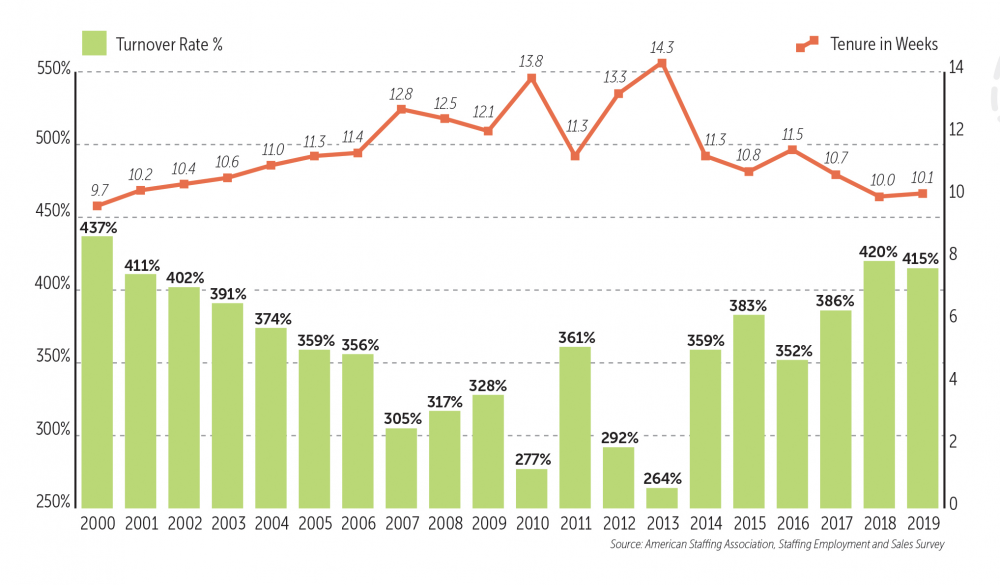
For staffing firms, turnover is key to your success and net profit. Human Resource departments typically measure employee turnover on a weekly or monthly basis and a low turnover rate is highly desired by both clients and the staffing firms servicing them. Costs are reduced in advertising, recruiting, testing, onboarding and training. Front and back office staffing software covers all of these areas and ensures efforts are not duplicated. This saves the staffing agency and client a considerable amount of money, time and energy.
2020 has been a difficult year, to put it mildly. Many industry experts have reservations to try and even guess at when, or if, the workforce will return to what it has been in prior years. Others say that it won’t ever be the same. A considerable amount of people now work remotely and this year has required employers to give their employees the ability to work from home, even if they were not keen on the idea. Some employees and firms love remote work and its results, while others do not.
Regardless, the staffing industry is resilient. It adapts and creates new opportunities and markets that were not there before. The staffing industry continues to not only be a valued source of temporary, temp to hire and direct hire staff for many firms, but is increasingly relied upon and seen as an HR partner. Staffing companies should look to this year as a unique opportunity to partner with current customers and seek new clients to work with in a strategic manner.
Additionally, there are countless opportunities to educate and connect with so many individuals who do not understand the role of a staffing company; how it can positively affect and assist in finding a role they will love. Start with this perfectly created value proposition by ASA as to what the staffing industry does for job candidates: “Job placement agencies help job seekers get noticed and land positions that match their qualifications at companies that are hiring.” Moreover, benefits of working with your staffing firm should be touted, potential job candidates should be engaged and new hires should be celebrated.
COATS Staffing Software allows your permanent staff to automate their job from beginning to end, so more time is spent with each job candidate, employee, prospective client and customer. Connection, even when remote, is needed. Personalized phone calls, resume review, best fit, job description details and follow-up takes considerable time and effort. Automate paperwork, connect with people. Call COATS or schedule a demo today.











